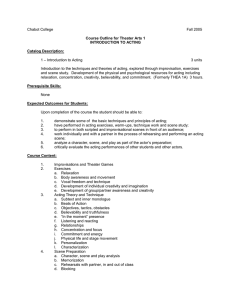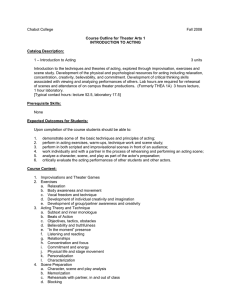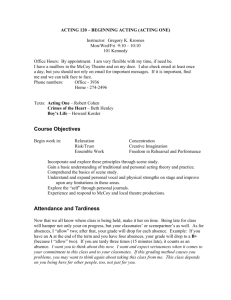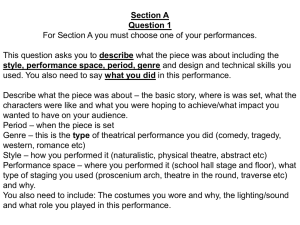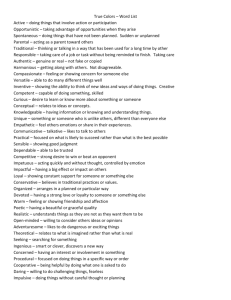Chabot College Fall 2004 – Theory and Practice of Acting I
advertisement
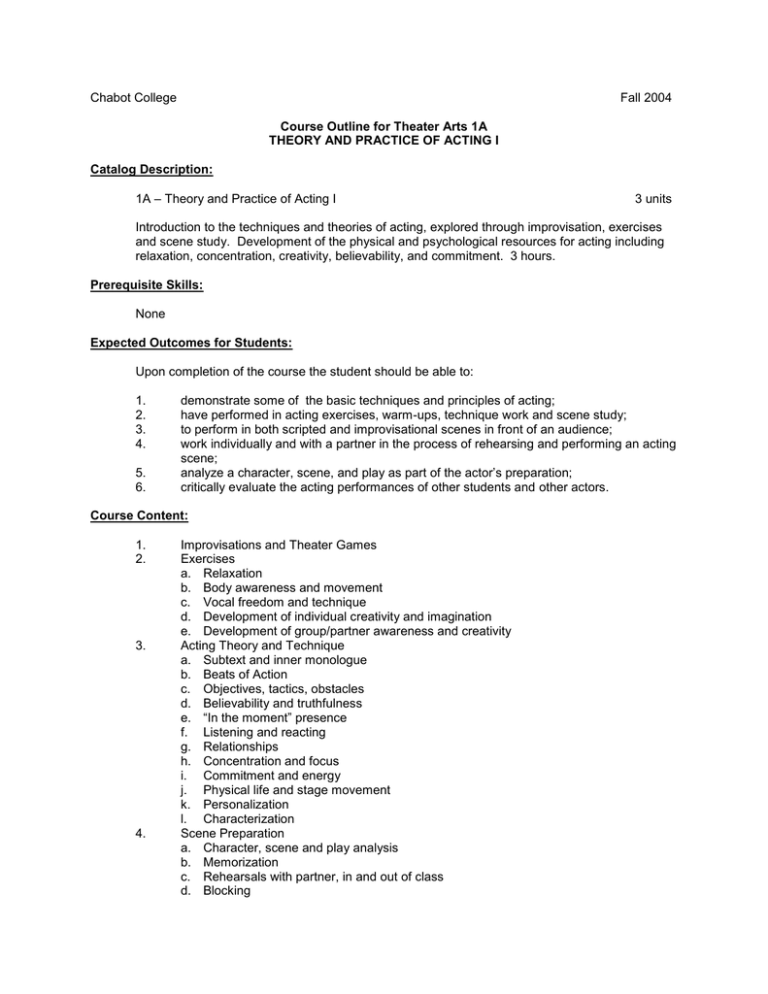
Chabot College Fall 2004 Course Outline for Theater Arts 1A THEORY AND PRACTICE OF ACTING I Catalog Description: 1A – Theory and Practice of Acting I 3 units Introduction to the techniques and theories of acting, explored through improvisation, exercises and scene study. Development of the physical and psychological resources for acting including relaxation, concentration, creativity, believability, and commitment. 3 hours. Prerequisite Skills: None Expected Outcomes for Students: Upon completion of the course the student should be able to: 1. 2. 3. 4. 5. 6. demonstrate some of the basic techniques and principles of acting; have performed in acting exercises, warm-ups, technique work and scene study; to perform in both scripted and improvisational scenes in front of an audience; work individually and with a partner in the process of rehearsing and performing an acting scene; analyze a character, scene, and play as part of the actor’s preparation; critically evaluate the acting performances of other students and other actors. Course Content: 1. 2. 3. 4. Improvisations and Theater Games Exercises a. Relaxation b. Body awareness and movement c. Vocal freedom and technique d. Development of individual creativity and imagination e. Development of group/partner awareness and creativity Acting Theory and Technique a. Subtext and inner monologue b. Beats of Action c. Objectives, tactics, obstacles d. Believability and truthfulness e. “In the moment” presence f. Listening and reacting g. Relationships h. Concentration and focus i. Commitment and energy j. Physical life and stage movement k. Personalization l. Characterization Scene Preparation a. Character, scene and play analysis b. Memorization c. Rehearsals with partner, in and out of class d. Blocking Chabot College Course Outline for Theater Arts 1A, Page 2 Fall 2004 5. Scene Presentation a. Performing scene before the class and instructor b. Feedback and coaching from instructor c. Second presentation of scene after feedback Methods of Presentation: 1. 2. 3. 4. 5. 6. Student participation in warm up exercises, improvisations and acting technique work Lectures, demonstrations and discussions on acting theories and techniques In-class and outside-of-class rehearsal of scenes and monologues, with as much coaching and guidance by the instructor as possible Prepared performances of scenes and monologues. Evaluation and critique of this performance work by instructor Reading and analyzing the plays from which scenes are taken Reading from textbooks or handouts Assignments and Methods of Evaluating Student Progress: 1. Typical Assignments a. Reading the entire play from which an individual’s acting scene in taken, for the purpose of understanding characterization, theme, plot, style, etc. Writing a play and character analysis based on an outline provided by the instructor. b. Presenting a rehearsed scene in class, with lines memorized and blocking created, using acting techniques and principles learned in class c. Writing a review of a live theatrical performance, with particular attention given to a critique of the acting. 2. Methods of Evaluating Student Progress a. Grading of prepared scenes and monologues, based on the objective quality of the work and the amount of improvement and growth shown by student. b. Grading of written play and character analyses. c. Grading of tests or quizzes. d. Judgment of participation in class improvisations, discussions and technique work e. Grades should be assigned and communicated as soon as possible after prepared work is done. Participation grade should be made known to student at least once in the middle of the semester. Textbook(s) Typical: Acting is Believing. Charles McGaw and Larry Clark, Holt Rinehart & Winston, 1992. Special Student Materials: Handouts provided by instructor G:\Curriculum2004\Theater Arts 1A DZ Revised: 11/4/03
